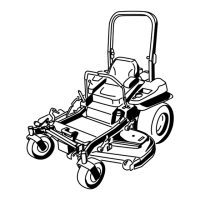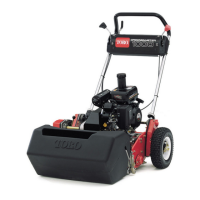26
1
m–3385
Figure 27
1. Spark plug wire
Checking the Spark Plug
1. Look at the center of the spark plug(s) (Fig. 28). If you
see light brown or gray on the insulator, the engine is
operating properly. A black coating on the insulator
usually means the air cleaner is dirty.
Important Never clean the spark plug(s). Always
replace the spark plug(s) when it has: a black coating,
worn electrodes, an oily film, or cracks.
2. Check the gap between the center and side electrodes
(Fig. 28). Bend the side electrode (Fig. 28) if the gap is
not correct.
0.040
(1.02 mm)
2
3
1
Figure 28
1. Center electrode insulator
2. Side electrode
3. Air gap (not to scale)
Installing the Spark Plug(s)
1. Install the spark plug(s) and metal washer. Make sure
the air gap is set correctly.
2. Tighten the spark plug(s) to 30 ft. lb. (41 N m).
3. Push the wire(s) onto the spark plug(s) (Fig. 27).
4. Close the hood.
Greasing and Lubrication
Service Interval/Specification
Grease the machine after every 50 operating hours or
yearly, whichever occurs first. Grease more frequently
when operating conditions are extremely dusty or sandy.
Grease Type: General-purpose grease.
How to Grease
1. Disengage the power take off (PTO), set the parking
brake, and turn the ignition key to off. Remove the
key.
2. Clean the grease fittings with a rag. Make sure to
scrape any paint off the front of the fitting(s).
3. Connect a grease gun to the fitting. Pump grease into
the fittings until grease begins to ooze out of the
bearings.
4. Wipe up any excess grease.
Where to Add Grease
1. Lubricate the front wheels, spindles and tie-rod ends
until grease begins to ooze out of the bearings (Fig.
29).
2. Lubricate the front axle pivot (Fig. 29).
m–2510
Figure 29
3. Lubricate the pedal(s) where it pivots on the mounting
shaft, steering shaft and spread grease on steering
sector teeth (Fig. 30).

